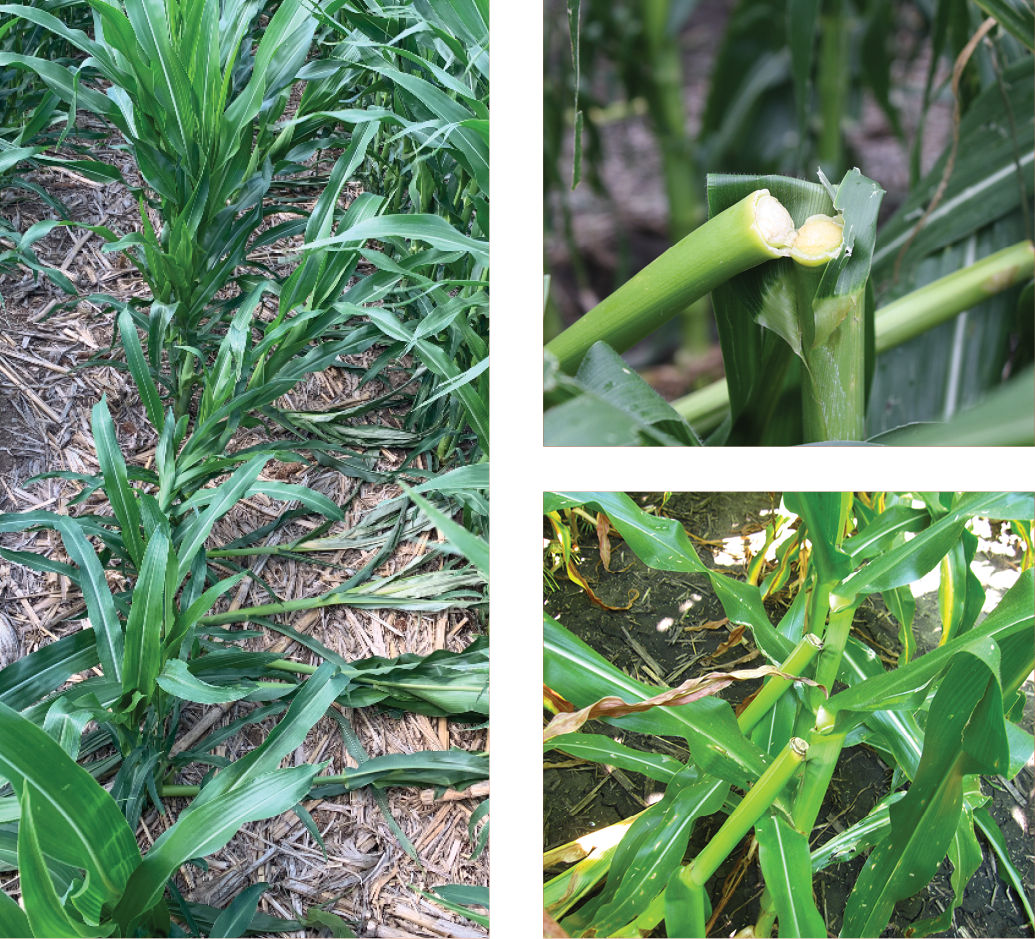5 MIN READ
Effect of Greensnap Injury on Corn Yield Potential
July 16, 2020
• Greensnap occurs mainly in the western to central corn growing area where thunderstorms with high winds are more prevalent.
• Rapidly growing corn in the late vegetative stages to tasseling is most vulnerable to greensnap.
• The effect of greensnap on yield potential depends on how many stalks were snapped and where on the stalk the breakage occurred.
Greensnap Injury and Corn Growth
Greensnap is the breakage of corn stalks at a node caused by high winds (Figure 1). It is also referred to as brittle stalk or brittle snap injury. This weather- related agronomic phenomenon is observed when violent thunderstorms with strong winds occur during corn growth stages when internodes are rapidly elongating and are susceptible to breakage. There are usually two windows of potential greensnap injury, growth stages V5 to V8 and V10 to R2.
Growth regulator herbicides can increase the potential risk of greensnap during the V5 to V8 window when the growing point is just emerging from the soil line.

Figure 1. Greensnap injury in corn.
The corn plant goes through the most rapid rate of growth from growth stages V10 to R2. In a period of 17 to 21 days, corn grows from around 4 feet to its mature height of 7 to 10 feet. During this rapid stage of growth, leaf surface area increases logarithmically. This rapid growth and increase in surface area coincides with the period of greatest potential risk of severe thunderstorms during July and early August.
Typically, greensnap injury is observed at the primary ear node or the node above or below the primary ear node. However, wind speeds above 80 mph can result in breakage at nodes above or below these typical sites.
Once a node has stopped expanding, cell walls are strengthened by the deposition of lignin that prevents breakage at that node. Straight line wind events after R1 or R2 may result in stalks kinking over or even breaking between nodes, but not actual greensnap stalk breakage, which is at a node.
Assessing Storm Damage
The factors with the largest impact on greensnap damage in a particular field are the timing and severity of the wind relative to corn growth stage. Damaging thunderstorms that occur in early morning hours typically cause the most damage during the V10 to R2 growth stage. At the base of every node is a region called a meristem, which is an area of rapidly dividing cells. Stalk growth occurs as a result of turgor pressure from water in the stalk expanding the size of these newly divided cells. Corn plants are most brittle when turgor pressure is the greatest in early morning hours, when plants have taken up water overnight and are not under the heat stress of higher daytime temperatures.
Damaging winds often occur in the first minutes of a severe thunderstorm before soils are softened by rain. Fields with strong deep root systems in dry, firm soil may have more greensnap injury than fields with shallow root systems. Weaker root systems will tend to lodge under similar wind conditions.
Greensnap injury typically occurs at the node still undergoing rapid expansion, but that has yet to be strengthened by lignin and other structural materials in the cell walls. Neighboring fields may break at different levels or different nodes because product maturity, planting date, and other management factors can result in different nodes being vulnerable for a specific field when a wind event occurs.
The yield effects of greensnap depends on the number of plants snapped in a field and where the breakage occurs on the stalk.2 In many cases, yield loss for a greensnap event is directly related to the number of plants snapped. For example if 10% of the plants are broken at a lower node or near the base of the plant, a grower can expect a 10% yield reduction.3 Depending on the timing of the greensnap event, the adjacent, uninjured corn plant may have already determined maximum production of the ear and may not have the ability to compensate for reduced plant competition.Stalks that break above the ear will usually continue to grow and produce an ear; however, yield reductions may occur if nearby plants shade the broken plant.2 When the stalk breaks at a node below the first ear, an ear may form at a lower node, but this ear may not receive enough pollen to produce many kernels.2
A study conducted at North Dakota State University from 2015 through 2017 assessed the effects of greensnap injury to corn (Table 1). The study evaluated corn yield loss resulting from three levels of simulated injury (25, 50, and 75%) during different stages of corn growth (V12, V15, V18). Overall, results showed that yield losses increased when a higher percentage of plants were damaged and when injury occured at a later growth stage.

Additional Factors
Straight line winds during a severe thunderstorm are highly variable and unpredictable. This variability is easier to see when assessing damage to trees, grain bins, buildings, or telephone poles. Variability will also occur in corn fields where straight line winds can result in narrow zones of destruction with highly variable patterns in fields.
A frustrating aspect of assessing wind damage is that it is often the highest yield potential fields that have the highest level of crop injury. A University of Nebraska study found that there was a direct correlation to higher rates of nitrogen and increased severity of greensnap damage.1 Crop managementnecessary for high yield potential contributes to rapid growth, which in turn can influence the level of wind injury.
Yield loss for pinched stalks or root-lodged plants can be more difficult to estimate, as the plant may be able to reorient to a vertical position and produce an ear.
Managing the Risk
Planting corn products with varied maturities and spreading planting dates can help to widen the window of corn growth and development for a specific storm event. When considering the risk of greensnap injury, keep these additional points in mind:
- Factors that favor early-season corn growth such as high nitrogen, phosphorus, and potassium fertilizer rates, tillage, and high organic matter, also tend to increase greensnap susceptibility.
- Follow the herbicide label for timing, tank-mix partners and additives for all post-emergence herbicide applications.
- Protect your financial risk from weather-related crop injury by purchasing crop insurance. Notify your crop insurance provider of any damage following a storm event to determine if compensation is available.
Sources
(verified 7/10/20)
1Elmore, R.W. et al. 2003. Corn greensnap from extreme wind is influ-enced by several factors. Crop Management. https://www.ag.ndsu.edu/cpr/plant-science/green-snap-in-corn-07-05-18.
2Nafziger, E. 2011. Damage in corn. Integrated Pest Management: The Bulletin. University of Illinois Extension No. 15 Article 5.
3Elmore, R. et al. 2006. Storm induced breakage (greensnap). Integrated Crop Management. Iowa State University. Pg 199-200. IC—496. 4 Ransom, J. 2018. Green snap in corn. North Dakota State University. https://www.ag.ndsu.edu/cpr/plant-science/green-snap-in-corn-07-05-18.
5018_S2






